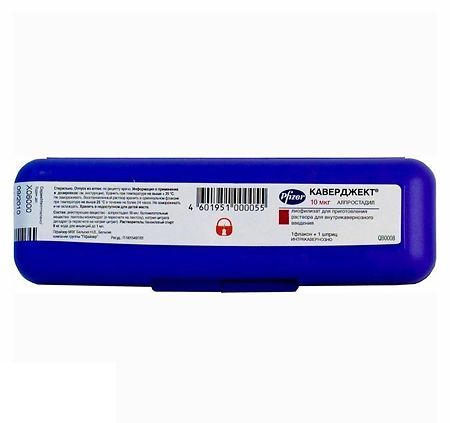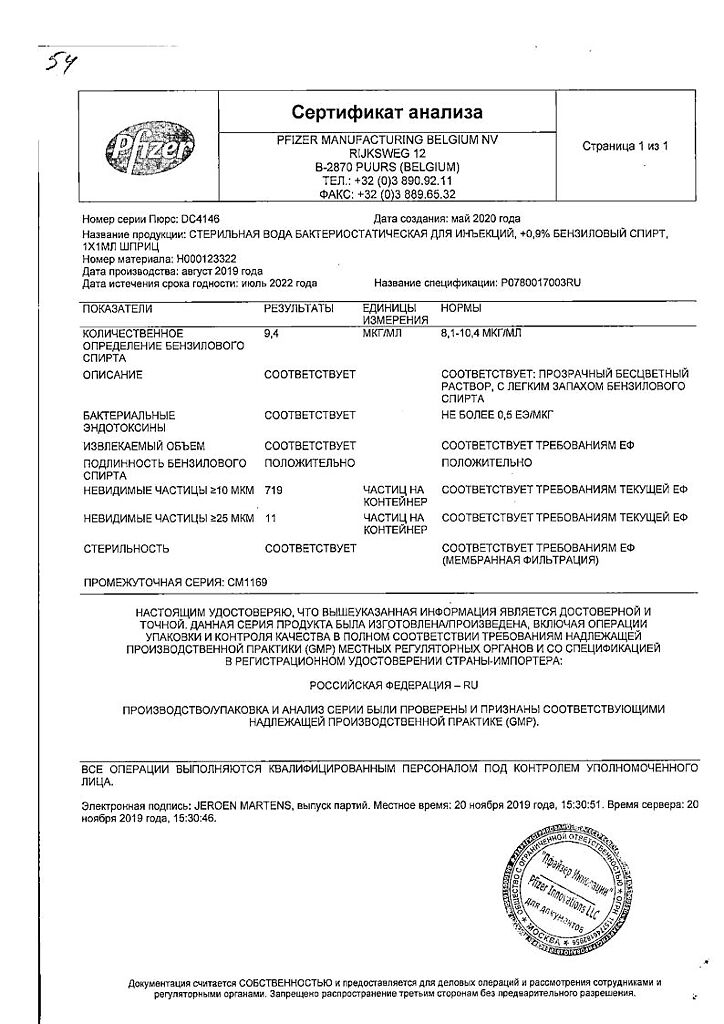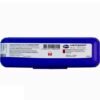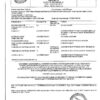No products in the cart.
Caverject, 10 mcg lyophilizate 1 pc+(1 ml in syringe)
€59.97 €51.98
Description
Caverject is prescribed for erectile dysfunction.
In intracavernosal administration (in the penis), alprostadil inhibits alpha1-adrenoreceptors of penile tissue, relaxes the muscles of the cavernous bodies, increases blood flow and improves microcirculation, causes an erection by relaxation of the trabecular smooth muscles of cavernous bodies and dilation of the cavernous arteries.
Indications
Indications
Erection disorders of neurogenic, vascular, psychogenic or mixed etiology, diagnosis of erectile dysfunction in addition to other diagnostic tests.
Pharmacological effect
Pharmacological effect
Caverject is prescribed for erectile dysfunction.
When administered intracavernosally (into the penis), alprostadil inhibits alpha1-adrenergic receptors of penile tissue, relaxes the muscles of the cavernous bodies, increases blood flow and improves microcirculation, causes an erection by relaxing the trabecular smooth muscles of the cavernous bodies and dilatation of the cavernous arteries.
Special instructions
Special instructions
The condition of the patient undergoing self-treatment should be constantly monitored, especially in the initial period when dose changes may be required. Every 3 months the patient is recommended to visit the attending physician to assess the effectiveness and safety of treatment and dose adjustment (if necessary).
The bottle with the diluted drug is intended for single use and is discarded after use. The patient should be instructed about the rules for disposing of the needle, syringe and vial.
It is known that after intracavernosal administration of vasoactive drugs, including CAVERJECT, priapism (erection lasting more than 6 hours) may develop. To reduce the risk of developing priapism, the lowest effective dose should be administered. The patient should immediately report to the doctor any cases of erection lasting more than 4 hours. Treatment of priapism is carried out in accordance with established medical practice.
Before initiating therapy with CAVERDJECT, a diagnosis of treatable causes of erectile dysfunction should be carried out.
The first injections of the drug should be carried out in a doctor’s office by specially trained medical personnel. Self-injections can be started only after detailed instructions have been given to the patient and he has mastered the technique of self-injections. The physician must carefully assess the patient’s skills and ability to perform this procedure. Intracavernous administration should be carried out in compliance with the rules of asepsis.
After intracavernous administration of the drug, penile fibrosis may develop, including penile angulation, formation of fibrous nodules and Peyronie’s disease. The incidence of fibrosis may increase with increasing duration of drug use. Regular examination of patients with careful examination of the penis is strongly recommended to identify signs of penile fibrosis or Peyronie’s disease. In patients who develop penile angulation, cavernous fibrosis or Peyronie’s disease, treatment with the drug should be discontinued.
Since minor bleeding is possible with intracavernosal administration, patients using CAVERJECT should be aware of measures to protect against sexually transmitted infections and blood-borne infections, including human immunodeficiency virus (HIV). Patients treated with anticoagulants such as warfarin or heparin have an increased tendency to bleed after intracavernous injection.
Special monitoring is necessary in patients receiving MAO inhibitors, and in case of prolonged erection in those treated with α-adrenergic agonists (a hypertensive crisis may develop); as well as in patients with coronary artery disease, chronic heart failure or pulmonary disease (sexual stimulation and sexual intercourse can lead to exacerbation of the disease).
The compliance of the dosage form of alprostadil used with the specific indications for its use should be strictly observed.
Active ingredient
Active ingredient
Alprostadil
Composition
Composition
Composition of the drug:
active substance
alprostadil 10 mcg,
excipients:
lactose,
sodium citrate.
Solvent composition:
benzyl alcohol 9 mg, water for injection q.s. 1 ml., dosage form: lyophilisate for preparing a solution for intracavernous administration.
Contraindications
Contraindications
Established hypersensitivity to the components of the drug, diseases that may predispose to the occurrence of priapism, such as sickle cell anemia, myeloma, leukemia, anatomical deformations of the penis (angulation of the penis, cavernous fibrosis, Peyronie’s disease), the presence of a penile implant, men for whom sexual activity is contraindicated or not recommended.
Side Effects
Side Effects
Local (less than 1%): priapism (duration of erection more than 6 hours), balanitis, hemorrhages at the injection site, inflammation, itching and swelling at the injection site, bleeding from the urethra, feeling of warmth in the penis, numbness, fungal infection, irritation, increased sensitivity of the skin (hyperesthesia), phimosis, itching, erythema, “venous discharge” from cavernous bodies, painful erection, ejaculation disorders.
Local (most often): pain and burning in the penis, prolonged erection (duration 4-6 hours), fibrosis of the penis, hematoma and ecchymosis at the injection site. Penile fibrosis, including penile angulation, fibrous nodule formation, and Peyronie’s disease, occurs in 3 to 8% of patients. Injection site hematoma (3% of patients) and injection site ecchymosis (2% of patients) are related to injection technique rather than to the effects of alprostadil. The frequency of prolonged erection (4-6 hours) was 4%.
Systemic effects (most common): increased blood pressure, dizziness, headache, back pain, upper respiratory tract infections, flu-like syndrome, sinusitis, nasal congestion, cough, prostatitis, pain not at the injection site.
Systemic effects (less than 1%): testicular pain, testicular swelling, testicular warmth, testicular thickening, scrotal redness, scrotal pain, spermatocele, scrotal swelling, hematuria, urinary dysfunction, increased frequency of urination, urinary urgency, pelvic pain, decreased blood pressure, tachycardia, vasodilation, peripheral vascular disorders, supraventricular extrasystole, vasovagal reactions, hypesthesia, muscle weakness, hyperhidrosis, rash, itching not at the injection site, nausea, dry mouth, increased serum creatinine, calf muscle cramps, dilated pupils.
Interaction
Interaction
Not intended for mixing or simultaneous administration with other drugs, as well as for joint use with other drugs for the treatment of erectile dysfunction.
The possibility of pharmacokinetic interactions with other drugs has not been studied.
Concomitant use with antihypertensive drugs, diuretics, antidiabetic drugs (including insulin), or nonsteroidal anti-inflammatory drugs does not have any effect on the safety or effectiveness of the drug.
Overdose
Overdose
Symptoms: pain in the penis, prolonged erection and/or priapism, irreversible deterioration of erectile function.
Treatment: if the erection lasts less than 6 hours, medical supervision is necessary, since spontaneous detumescence often occurs (cessation of erection, reduction in the size of the genital organs due to the outflow of blood), if more than 6 hours, an intracavernous injection of α-adrenergic agonists (for example, ephedrine, epinephrine, phenylephrine, etilephrine) should be performed or blood aspiration from the cavernous bodies or carry out surgical treatment.
The patient should be under medical supervision until the systemic symptoms disappear and/or until complete detumescence of the penis occurs.
Storage conditions
Storage conditions
List B. Store at a temperature not exceeding 25°C out of the reach of children.
Shelf life
Shelf life
Shelf life of the lyophilisate: 2 years.
Manufacturer
Manufacturer
Pfizer Manufacturing Belgium NV, Belgium
Additional information
| Shelf life | Shelf life of the lyophilizate: 2 years. |
|---|---|
| Conditions of storage | List B. Store at the temperature not more than 25 ° C out of the reach of children. |
| Manufacturer | Pfizer MFG. Belgium N.V., Belgium |
| Medication form | lyophilizate |
| Brand | Pfizer MFG. Belgium N.V. |
Related products
Buy Caverject, 10 mcg lyophilizate 1 pc+(1 ml in syringe) with delivery to USA, UK, Europe and over 120 other countries.


















